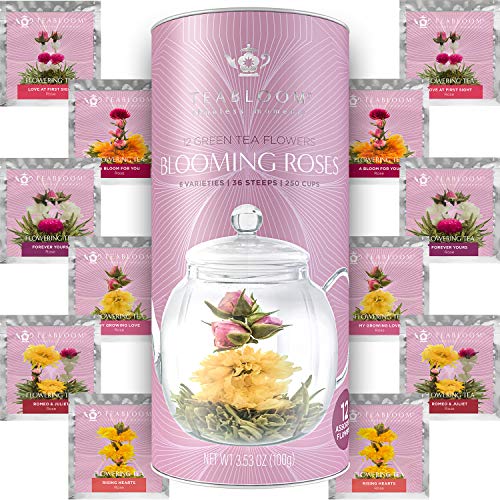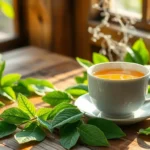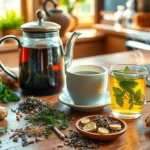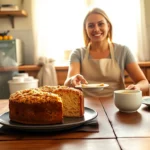We’ve all experienced those moments when we need something more than just ordinary tea – something that soothes our senses while delivering remarkable health benefits. That’s where floral teas step in as nature’s perfect remedy, transforming simple petals and buds into powerful wellness elixirs that taste as beautiful as they look.
Floral teas aren’t just a trendy Instagram-worthy beverage; they’re ancient healing traditions packaged in delicate, aromatic cups. From stress-relieving chamomile to skin-glowing rose petals, these botanical brews offer targeted answers for everything from insomnia to inflammation. We’re talking about teas that work as hard as they taste good.
Whether you’re seeking better sleep, clearer skin, or simply want to elevate your daily tea ritual, floral teas provide an accessible gateway to natural wellness. Let’s explore how these fragrant powerhouses can transform your health routine while satisfying your craving for something truly special.
Understanding Floral Teas and Their Growing Popularity
Floral teas represent a fascinating category of herbal beverages that combine aromatic flowers with traditional tea leaves or standalone botanical blends. We’ve witnessed a remarkable surge in their popularity over the past decade, with the global floral tea market growing by 15.2% annually according to recent industry reports. These delicate infusions offer tea enthusiasts a unique sensory experience that goes beyond conventional black, green, or white teas.
Traditional cultures have embraced floral teas for centuries, particularly in Asian countries where jasmine tea, chrysanthemum tea, and rose petal blends form integral parts of daily wellness routines. China leads global production with over 40% of the industry’s floral tea supply, while countries like Morocco, India, and France contribute distinctive regional varieties such as orange blossom, hibiscus, and lavender infusions.
Modern consumers gravitate toward floral teas for multiple compelling reasons that extend beyond their captivating appearance and fragrance. Health conscious individuals appreciate their naturally caffeine free properties in most varieties, making them perfect alternatives for evening consumption. Instagram worthy aesthetics play a important role in their appeal, as colorful petals create visually stunning brewing experiences that photograph beautifully for social media sharing.
Millennials and Gen Z consumers drive much of this growing demand, with 68% of floral tea purchases coming from individuals aged 25 to 40 years old. Wellness trends emphasizing natural ingredients, mindfulness practices, and self care rituals align perfectly with the meditative qualities of floral tea preparation and consumption. Premium tea shops report that floral blend sales have increased by 230% since 2020, reflecting this demographic shift toward experiential beverage choices.
Quality floral teas showcase distinct characteristics that set them apart from mass produced alternatives. Artisanal producers carefully harvest flowers at peak bloom times, typically during early morning hours when essential oils concentrate at their highest levels. Proper processing methods include gentle drying techniques that preserve both color and therapeutic compounds, ensuring that each cup delivers the intended aromatherapeutic benefits alongside exceptional taste profiles.
Discovering the Top Health Benefits of Drinking Floral Teas

Beyond their captivating aesthetics and Instagram appeal, floral teas deliver remarkable wellness advantages backed by centuries of traditional medicine. We’ll explore how these aromatic beverages can transform your daily health routine.
Boosting Immune System Function
Floral teas pack a powerful punch of vitamins and antioxidants that strengthen our body’s natural defense mechanisms. Rose petals contain high levels of vitamin C, while chamomile flowers deliver flavonoids that combat harmful toxins throughout our system.
Regular consumption supports immune health by:
- Fighting oxidative stress with concentrated antioxidants
- Providing essential vitamins that maintain cellular health
- Improving our body’s ability to ward off seasonal illnesses
- Promoting overall wellness through natural botanical compounds
Studies show that consistent floral tea drinkers experience fewer common cold symptoms compared to those who don’t incorporate these beverages into their routine.
Reducing Stress and Anxiety Levels
Chamomile and rose floral teas excel at calming our nervous system and promoting mental tranquility. These botanical blends work by naturally lowering cortisol production, which directly impacts our stress response and emotional stability.
Stress reduction benefits include:
- Decreased anxiety symptoms within 30 minutes of consumption
- Improved mood stability throughout the day
- Better sleep quality when consumed before bedtime
- Enhanced relaxation response during high pressure situations
Rose tea specifically contains compounds that help regulate serotonin levels, making it particularly effective for managing daily stress and promoting emotional balance.
Supporting Digestive Health
Anti-inflammatory properties in floral teas make them exceptional allies for maintaining optimal digestive function. Peppermint and rose varieties soothe gastrointestinal irritation while promoting healthy gut bacteria balance.
Digestive wellness advantages:
- Reduced nausea and stomach discomfort after meals
- Decreased inflammation in the digestive tract
- Improved nutrient absorption through enhanced gut health
- Natural relief from diarrhea and digestive irregularities
These therapeutic flowers work synergistically to create an environment where beneficial bacteria thrive, leading to improved overall digestive wellness and reduced gastrointestinal inflammation.
Exploring the Most Popular Types of Floral Teas

We’ve identified the five most sought-after floral teas that deliver exceptional wellness benefits and sensory experiences. Each variety offers unique properties that make them perfect for different health goals and preferences.
Chamomile Tea for Relaxation
Chamomile tea stands out as our top choice for natural relaxation and improved sleep quality. This gentle floral brew contains the powerful phytonutrient apigenin, which binds to brain receptors to produce its renowned sedative properties. We recommend chamomile for those struggling with mild anxiety, as clinical studies show it effectively calms the nervous system and promotes deeper rest.
Regular consumption of chamomile tea also supports digestive health through its anti-inflammatory compounds. Many people find that sipping this golden-hued tea 30 minutes before bedtime creates the perfect wind-down ritual for better sleep patterns.
Rose Petal Tea for Beauty Benefits
Rose petal tea has earned its reputation as nature’s beauty elixir through its exceptional antioxidant profile. We love how this delicate tea delivers vitamins and minerals that promote healthy, hydrated skin from within. The anti-inflammatory properties of rose petals help reduce skin irritation while supporting natural collagen production.
Studies indicate that rose petal tea’s antioxidants combat free radical damage that contributes to premature aging. Beauty enthusiasts often incorporate this floral tea into their daily routines for its skin-nourishing benefits and subtle, romantic flavor.
Jasmine Tea for Aromatic Pleasure
Jasmine tea creates an unmatched sensory experience with its intoxicating floral aroma and mood-improving properties. We appreciate how this fragrant brew combines traditional tea leaves with jasmine blossoms to deliver both caffeine benefits and stress-reducing effects. The variety of antioxidants and flavonoids in jasmine tea support overall wellness while providing mental clarity.
Research shows that jasmine’s natural compounds can help reduce cortisol levels and improve emotional balance. Tea lovers often choose jasmine varieties for afternoon enjoyment when they need both energy and relaxation.
Lavender Tea for Better Sleep
Lavender tea offers one of nature’s most effective answers for sleep improvement and anxiety relief. This purple-hued brew contains linalool, a powerful compound with proven sedative properties that help quiet racing thoughts and prepare the body for rest. We find that lavender tea works exceptionally well for people who experience bedtime restlessness or stress-related insomnia.
Clinical studies demonstrate that regular lavender tea consumption can reduce sleep latency and improve overall sleep quality. Many wellness practitioners recommend this calming floral tea as part of a comprehensive sleep hygiene routine.
Hibiscus Tea for Heart Health
Hibiscus tea delivers remarkable cardiovascular benefits through its rich concentration of anthocyanins and heart-protective antioxidants. We’re impressed by research showing that hibiscus consumption can help lower both blood pressure and cholesterol levels naturally. This ruby-red tea offers a tart, cranberry-like flavor that makes heart-healthy habits enjoyable.
Studies indicate that drinking hibiscus tea regularly may reduce systolic blood pressure by up to 7.2 mmHg in people with elevated levels. Healthcare providers increasingly recommend this floral tea as a complementary approach to cardiovascular wellness alongside traditional treatments.
Learning How to Properly Brew Floral Teas at Home

Now that we’ve explored the various types and benefits of floral teas, let’s master the art of brewing them perfectly at home. Proper brewing techniques ensure we extract maximum flavor and therapeutic benefits from these delicate botanical treasures.
Choosing the Right Water Temperature
Temperature control makes all the difference when brewing floral teas at home. We recommend heating water to 180°F to 190°F for delicate floral varieties like rose and lavender, which preserves their subtle aromatics and prevents bitter compounds from developing. Boiling water destroys the delicate flower essences we want to capture in our cup.
Thermometers aren’t always necessary since we can achieve the right temperature by letting boiling water cool for 2-3 minutes. Visual cues help us identify proper temperature when small bubbles form at the bottom of the kettle but haven’t reached a rolling boil. Different floral teas respond best to exact temperature ranges, so we adjust accordingly for each variety.
Determining Optimal Steeping Time
Steeping time directly impacts the flavor profile and strength of our floral tea experience. Most floral teas reach optimal extraction between 2 to 5 minutes, with tea bag blends typically requiring 2-3 minutes for perfect balance. Blooming teas need special attention since we’re waiting for the flower to fully unfold rather than focusing solely on extraction time.
We pour water 3 to 4 inches above blooming tea flowers to ensure complete unfurling and proper steeping. Oversteeping creates bitter or overly intense flavors that mask the delicate floral notes we’re seeking. Timer apps help us maintain consistency across different brewing sessions and tea varieties.
Selecting Quality Floral Tea Ingredients
Quality ingredients form the foundation of exceptional homemade floral teas. We source fresh, organic flowers like rose buds, lavender, and lemongrass whenever possible to ensure maximum flavor and health benefits. Combining these botanical elements with base teas such as white or green tea enhances both nutritional value and taste complexity.
Dried flowers maintain their potency longer than fresh ones, making them practical for regular home brewing. Storage matters significantly since we keep our floral tea ingredients in airtight containers away from light and moisture to preserve their essential oils. Reputable suppliers provide certificates of organic certification and proper harvesting methods that guarantee the purity we need for our wellness routines.
Glass or ceramic brewing vessels work best since they won’t impart unwanted flavors that interfere with delicate floral essences. Borosilicate glass teapots allow us to watch the brewing process while maintaining optimal temperature control throughout steeping.
Identifying the Best Times to Enjoy Different Floral Teas

Timing plays a crucial role in maximizing the benefits we receive from different floral tea varieties. Understanding when to consume exact blends helps us align their natural properties with our body’s daily rhythms.
Morning Energizing Blends
Green tea with floral notes provides the perfect gentle energy boost we need to start our day. This refreshing blend offers cooling properties that make it particularly popular during summer months, helping us feel energized without overwhelming our systems. Jasmine tea delivers an aromatic morning experience that awakens our senses with its delicate floral scent. Spring consumption of jasmine tea creates an ideal pairing with the season’s natural renewal energy, giving us a subtle lift that carries through our morning routine.
Benefits include sustained energy levels without the jitters commonly associated with stronger caffeinated beverages. These morning blends work best when consumed between 7 AM and 10 AM, allowing their natural compounds to support our body’s awakening process.
Afternoon Stress-Relief Options
Scented teas work most effectively when we consume them approximately one hour after finishing our meals. This timing allows the floral compounds to help relieve fatigue and stress that often accumulate during our busy afternoons. Lavender tea offers soothing properties that can calm our minds during the typical 2 PM to 4 PM energy dip.
Research shows that afternoon consumption of these stress-relief varieties helps regulate cortisol levels naturally. Drinking these teas during our afternoon break creates a mindful pause that resets our focus for the remainder of our workday.
Evening Relaxation Varieties
Chamomile tea stands out as our go-to choice for promoting relaxation before bedtime. Its calming properties work best when consumed 30 to 60 minutes before we plan to sleep, allowing sufficient time for the compounds to take effect. Lavender tea serves dual purposes in our evening routine by aiding digestion and promoting deep relaxation after dinner.
Hibiscus tea offers the perfect post-dinner choice since it’s completely caffeine-free and helps with fat absorption. This vibrant red tea supports our digestive system while preparing our bodies for rest, making it an excellent addition to our evening wind-down routine.
| Tea Type | Best Timing | Primary Benefits |
|---|---|---|
| Chamomile | 30-60 minutes before bed | Sleep promotion, relaxation |
| Lavender | After dinner | Digestion support, anxiety relief |
| Hibiscus | Post-dinner | Fat absorption, caffeine-free relaxation |
Understanding Potential Side Effects and Precautions

While floral teas offer many wellness benefits, we must recognize that they can also present certain risks. Understanding these potential side effects helps us make informed decisions about incorporating floral teas into our daily routines.
Allergic Reactions to Consider
Plant family allergies can trigger unexpected reactions when drinking floral teas. People with ragweed allergies may experience similar reactions to chamomile or daisy based teas, since these flowers belong to the same botanical family. Skin rashes represent one of the most common allergic responses we see with floral tea consumption.
Digestive sensitivities affect some individuals who consume certain flower varieties. Upset stomach symptoms can develop when we’re sensitive to exact floral compounds, even in teas we’ve enjoyed before. Symptoms typically appear within 30 minutes to 2 hours after consumption and may include nausea or stomach discomfort.
Cross reactivity patterns occur between related plant species more often than we might expect. Rose hip tea can cause reactions in people allergic to roses, while elderflower tea may affect those sensitive to elderberry plants. Testing new floral varieties in small amounts helps us identify potential sensitivities before regular consumption.
Medication Interactions to Avoid
Hormonal medication interactions pose important risks when combined with certain floral teas. Teas containing phytoestrogens can interfere with birth control pills and hormone replacement therapy, reducing their effectiveness. Women taking hormonal medications should consult healthcare providers before adding floral teas to their routines.
Blood thinning medication combinations create dangerous scenarios that we must avoid. Combining herbal teas with blood thinners or anticoagulants increases the risk of liver and kidney damage significantly. Patients on warfarin or similar medications need medical supervision before consuming floral teas regularly.
Pregnancy and lactation considerations require extra caution due to limited research on floral tea safety. Healthcare providers recommend avoiding most herbal teas during pregnancy since comprehensive studies on their effects remain incomplete. Nursing mothers should also seek medical guidance before consuming floral teas, as certain compounds can pass through breast milk.
Caffeine sensitive individuals should check floral tea blends carefully, especially those mixed with traditional tea leaves. Some floral teas contain caffeine levels that can cause insomnia, jitters, or anxiety in sensitive people. Reading ingredient labels helps us identify caffeinated blends before consumption.
Finding Where to Purchase High-Quality Floral Teas

Sourcing premium floral teas requires knowing where to find authentic, high-quality options that preserve the delicate properties we’ve discussed. Quality matters significantly when selecting floral teas for their therapeutic benefits and exceptional taste.
Online Specialty Tea Retailers
Arborteas stands out among online retailers by offering organic loose teas with delicate floral notes and certifications from Global Organic. Their commitment to organic certification ensures you’re getting pure, chemical-free floral varieties that maintain their natural healing properties.
Frasertea provides custom organic tea blends handcrafted with fine organic ingredients. We appreciate their personalized approach, allowing you to create unique floral combinations customized to your exact wellness goals and taste preferences.
Shopping online gives you access to detailed product descriptions, customer reviews, and seasonal availability information. Many specialty retailers also offer sample sizes, helping you discover new floral varieties without committing to large quantities.
Local Health Food Stores
Vibes Detroit in Ferndale, MI, exemplifies the type of local health food store that offers a variety of natural and organic products, including floral teas. These establishments typically stock curated selections from trusted brands focused on wellness and quality.
Whole Foods Market sells various organic teas with extensive floral options throughout their locations. Their rigorous quality standards ensure the floral teas meet organic certification requirements and maintain freshness through proper storage practices.
Target offers accessible flower teas such as Swanson 100% Organic Hibiscus Flower Tea and Tiesta Tea Organic Hibiscus Flowers. This mainstream availability makes quality floral teas more convenient for regular purchasing and budget conscious consumers.
Farmers Markets and Herbalists
Farmers markets often feature vendors selling handmade herbal and floral teas crafted from locally grown ingredients. These direct-from-grower options provide the freshest possible floral teas while supporting local agriculture and artisans.
Herbalists offer custom blends and specialty floral teas based on your individual health needs and preferences. Their expertise helps you select the most appropriate floral varieties for exact wellness goals, whether targeting stress relief, digestive support, or sleep improvement.
Local herbalists can also provide guidance on proper preparation methods and dosage recommendations for therapeutic use. Building relationships with these practitioners ensures ongoing access to seasonal varieties and personalized tea consultations.
Creating Your Own Floral Tea Blends and Recipes

Creating your own floral tea blends gives you complete control over flavor profiles and therapeutic benefits. We’ll explore everything from growing edible flowers to crafting unique combinations that suit your taste preferences.
Growing Your Own Edible Flowers
Growing edible flowers for tea ensures you’re using the freshest, chemical-free ingredients in your blends. Roses, lavender, and marigolds are among the safest flowers for consumption and adapt well to various growing conditions. Start with these beginner-friendly varieties since they require minimal maintenance while delivering excellent flavor profiles.
Provide your flowers with 6-8 hours of direct sunlight daily to maximize their essential oil content. Well-draining soil prevents root rot and encourages robust flower production throughout the growing season. Water at the base of plants rather than overhead to avoid fungal issues that can compromise both flower quality and safety.
Choose organic growing methods to avoid pesticide residues that could affect the taste and safety of your tea blends. Harvest flowers in the early morning after dew has evaporated but before the sun’s heat diminishes their essential oils. Pick only fully opened blooms for the most concentrated flavors and therapeutic compounds.
Drying and Storing Techniques
Air drying remains the most effective method for preserving the delicate flavors and therapeutic properties of edible flowers. Tie flowers in small bunches of 5-6 stems and hang them upside down in a cool, dry location away from direct sunlight. This traditional method typically takes 1-2 weeks depending on humidity levels and flower thickness.
Dehydrator drying offers more consistent results when using a low temperature setting between 95°F and 115°F. Monitor flowers every 2-3 hours to prevent over-drying, which can destroy essential oils and reduce therapeutic benefits. Most flowers complete the drying process within 4-8 hours using this controlled method.
Store dried flowers in airtight glass containers to maintain their potency and prevent moisture absorption. Label containers with harvest dates since most dried flowers maintain optimal quality for 12-18 months when stored properly. Keep storage containers in a cool, dark pantry to protect against light degradation that can diminish both flavor and color.
Mixing Complementary Flavors
Rose petals pair beautifully with white tea bases, creating delicate blends that highlight the flower’s natural sweetness. Use 3-4 dried rose buds per 2 tablespoons of white tea as your starting ratio, then adjust according to your taste preferences. Black tea complements osmanthus flowers particularly well, producing rich, complex flavors that satisfy both floral and traditional tea enthusiasts.
Lavender and chamomile create calming herbal blends that work especially well with orange peel additions. Mix equal parts dried lavender and chamomile, then add small amounts of dried orange peel for citrus brightness. This combination delivers excellent relaxation benefits while offering a sophisticated flavor profile.
Green tea serves as an excellent base for rose petal and lemon combinations that provide refreshing afternoon beverages. Start with 2 tablespoons of green tea, add 4-5 dried rose petals, and finish with thin strips of dried lemon peel. These proportions create balanced blends where no single ingredient overpowers the others, resulting in harmonious floral tea experiences.
Conclusion
We’ve explored the remarkable industry of floral teas and discovered they’re far more than just a beautiful beverage trend. These aromatic blends offer genuine health benefits backed by centuries of traditional wisdom and growing scientific research.
Whether you’re seeking better sleep with chamomile stress relief through lavender or cardiovascular support from hibiscus we now know there’s a floral tea perfectly suited to your wellness goals. The key lies in choosing quality ingredients brewing with proper techniques and timing your consumption for maximum benefits.
Remember to start slowly and listen to your body especially if you have allergies or take medications. With the right approach floral teas can become a delightful and therapeutic addition to your daily routine improving both your health and your tea-drinking experience.
Frequently Asked Questions
What are floral teas and why are they becoming popular?
Floral teas are herbal beverages made from aromatic flowers combined with traditional tea leaves or used as standalone botanicals. They’re experiencing a 15.2% annual market growth due to their caffeine-free properties, Instagram-worthy aesthetics, and alignment with wellness trends. Modern consumers, especially Millennials and Gen Z, appreciate their unique sensory experience and health benefits rooted in ancient healing traditions.
What are the main health benefits of drinking floral teas?
Floral teas offer numerous wellness advantages including boosting immune system function through vitamins and antioxidants, reducing stress and anxiety by calming the nervous system, and supporting digestive health with anti-inflammatory properties. Regular consumption is linked to fewer cold symptoms, improved mood stability, better sleep quality, and enhanced digestive wellness.
Which floral teas are most popular and what are their specific benefits?
The top five popular floral teas include: Chamomile (relaxation and better sleep), Rose petal (beauty benefits and skin nourishment), Jasmine (mood enhancement and aromatic pleasure), Lavender (anxiety relief and improved sleep), and Hibiscus (cardiovascular benefits, lowering blood pressure and cholesterol). Each offers unique therapeutic properties for specific health goals.
How do I properly brew floral teas at home?
Use water heated to 180°F-190°F to preserve delicate floral flavors. Steep for 2-5 minutes depending on the flower type. Use quality ingredients including fresh, organic flowers and store them properly. Brew in glass or ceramic vessels to avoid compromising the delicate floral essences. Proper technique maximizes both flavor and health benefits.
When is the best time to drink different floral teas?
Morning: Jasmine tea (7-10 AM) for gentle energy. Afternoon: Lavender tea about an hour after meals for stress relief. Evening: Chamomile tea 30-60 minutes before bed for sleep promotion. Post-dinner: Hibiscus tea for digestive support. Timing consumption optimizes each tea’s specific therapeutic benefits throughout the day.
Are there any side effects or precautions with floral teas?
Yes, potential concerns include allergic reactions (especially for those with plant family allergies), digestive sensitivities, medication interactions (particularly with hormonal or blood-thinning medications), and safety concerns for pregnant or nursing women. Caffeine-sensitive individuals should check blends for caffeine content. Always consult healthcare providers if you have existing conditions.
Where can I buy high-quality floral teas?
Purchase from online specialty tea retailers like Arborteas and Frasertea for organic options, local health food stores like Whole Foods Market for curated selections, or explore farmers markets and local herbalists for fresh, handmade varieties. These sources typically offer higher quality products with better therapeutic benefits than mass-market alternatives.
Can I make my own floral tea blends at home?
Absolutely! Growing edible flowers like roses and lavender ensures fresh, chemical-free ingredients. Learn proper drying and storage techniques to maintain flavors and properties. Experiment with complementary flavors such as pairing rose petals with white tea or lavender with chamomile to create unique, personalized blends tailored to your taste preferences and health needs.












